Art installations today are transforming the way audiences interact with visual art, blending technology and creativity to create immersive experiences. By inviting participation, these interactive displays foster deeper connections, making the artwork more memorable and impactful. Successful installations captivate viewers with innovative elements and strong thematic concepts, enhancing their overall experience.
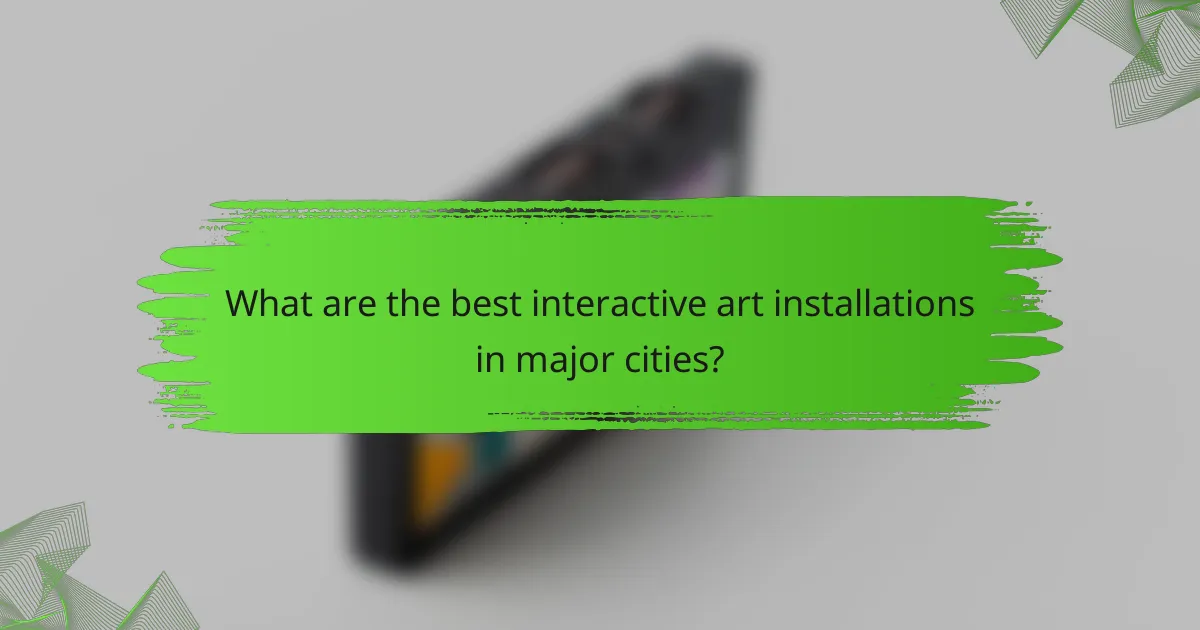
What are the best interactive art installations in major cities?
The best interactive art installations in major cities engage visitors through immersive experiences that blend technology and creativity. These installations often invite participation, making the audience an integral part of the artwork.
TeamLab Borderless in Tokyo
TeamLab Borderless is a groundbreaking digital art museum in Tokyo that offers a unique, immersive experience. Visitors can explore a vast space where art installations respond to their movements, creating a dynamic environment that changes in real-time.
Key features include interactive projections and installations that blend seamlessly into the surroundings, encouraging exploration and discovery. Be prepared for a sensory overload, as the experience is designed to be both visually stunning and thought-provoking.
The Vessel in New York City
The Vessel, located in Hudson Yards, is an interactive honeycomb-like structure that invites visitors to climb its staircases and enjoy panoramic views of the city. This architectural marvel encourages physical interaction, as guests can navigate its intricate pathways.
While entry is free, reservations are recommended to avoid long wait times. The Vessel’s design promotes social interaction, making it a popular spot for both tourists and locals to gather and share experiences.
Yayoi Kusama’s Infinity Mirror Rooms in Los Angeles
Yayoi Kusama’s Infinity Mirror Rooms are a series of immersive installations that create the illusion of endless space through mirrors and lights. These installations invite visitors to step inside and experience a mesmerizing visual journey that feels limitless.
Due to their popularity, timed tickets are often required, so plan ahead to secure your visit. The experience is not only visually captivating but also deeply personal, reflecting Kusama’s themes of infinity and self-identity.
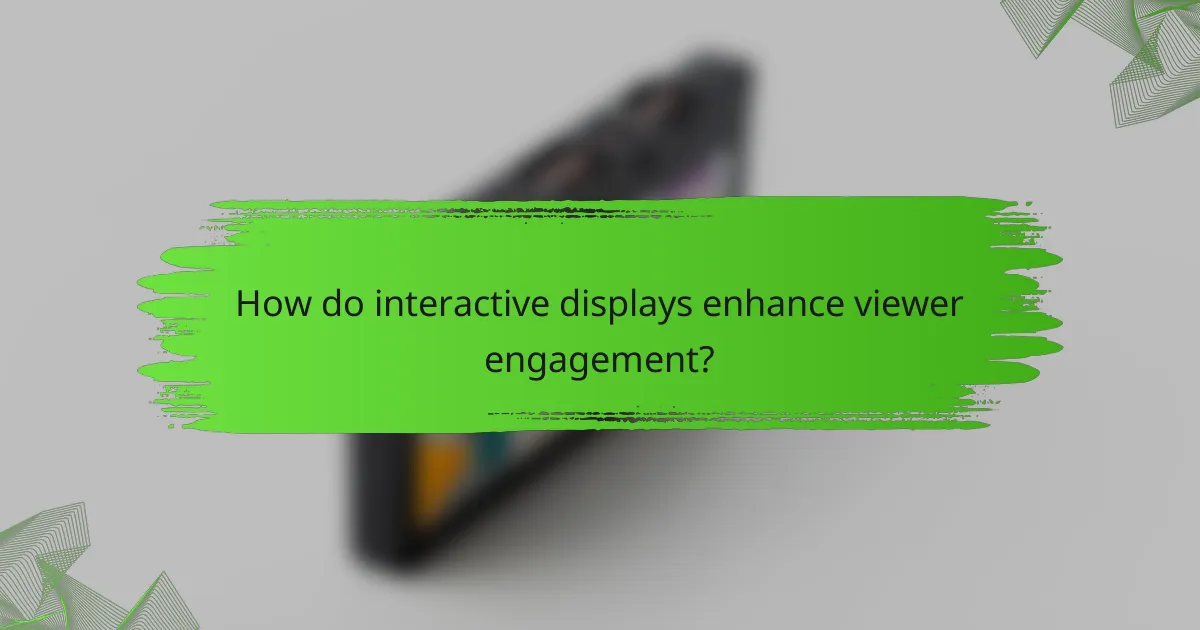
How do interactive displays enhance viewer engagement?
Interactive displays significantly enhance viewer engagement by allowing audiences to actively participate in the art experience. This hands-on involvement fosters a deeper connection with the artwork, making it more memorable and impactful.
Encourages participation
Interactive displays invite viewers to become part of the artwork, breaking down traditional barriers between the observer and the observed. By incorporating touchscreens, motion sensors, or augmented reality, these installations encourage users to explore and manipulate elements, leading to a more personalized experience.
For example, a digital mural that changes based on viewer interactions can create a sense of ownership and investment in the art. This participation can increase the time spent engaging with the installation, enhancing overall satisfaction and enjoyment.
Creates immersive experiences
Immersive experiences are a hallmark of interactive displays, as they transport viewers into a multi-sensory environment. By combining visual art with sound, light, and tactile elements, these installations can evoke strong emotional responses and create lasting memories.
Consider a virtual reality installation that allows users to step into a 3D art world. This type of engagement not only captivates attention but also encourages exploration and discovery, making the art more relatable and impactful. Such experiences can vary widely in duration, often lasting from a few minutes to an hour, depending on the complexity of the interaction.
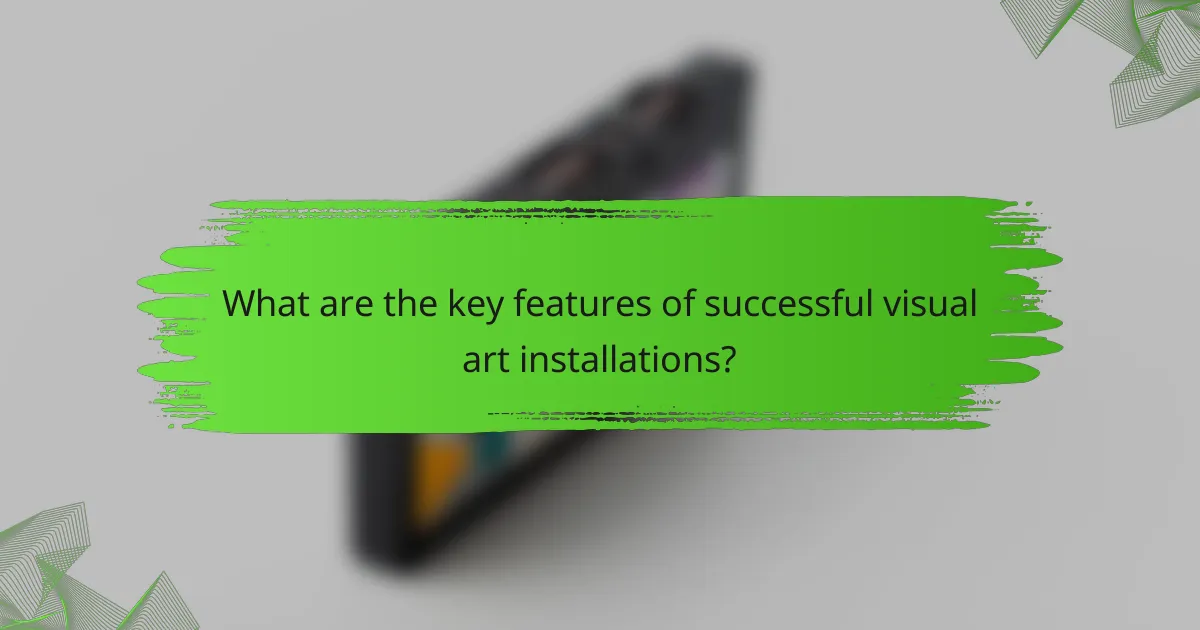
What are the key features of successful visual art installations?
Successful visual art installations often incorporate engaging elements that captivate audiences and provoke thought. Key features include innovative technology and strong thematic concepts that resonate with viewers, enhancing their overall experience.
Innovative use of technology
Innovative technology in visual art installations can transform the way audiences interact with art. This may include augmented reality, virtual reality, or interactive displays that respond to viewer movements or inputs. For instance, installations that use motion sensors can create a dynamic experience where the art changes based on audience participation.
When integrating technology, consider the balance between artistic intent and technical execution. Overly complex setups may detract from the art’s message, while simple, intuitive technology can enhance engagement. Ensure that the technology aligns with the overall theme and purpose of the installation.
Strong thematic concepts
Strong thematic concepts are essential for creating a meaningful visual art installation. Themes can range from social issues to personal narratives, providing a framework for the artwork. For example, an installation addressing climate change might use recycled materials to emphasize sustainability, making the theme tangible and relatable.
To develop a compelling theme, consider the emotions you want to evoke and the message you wish to convey. Engaging narratives can draw viewers in and encourage them to reflect on their own experiences. Avoid vague themes that may confuse the audience; instead, aim for clarity and depth to foster a stronger connection with the artwork.
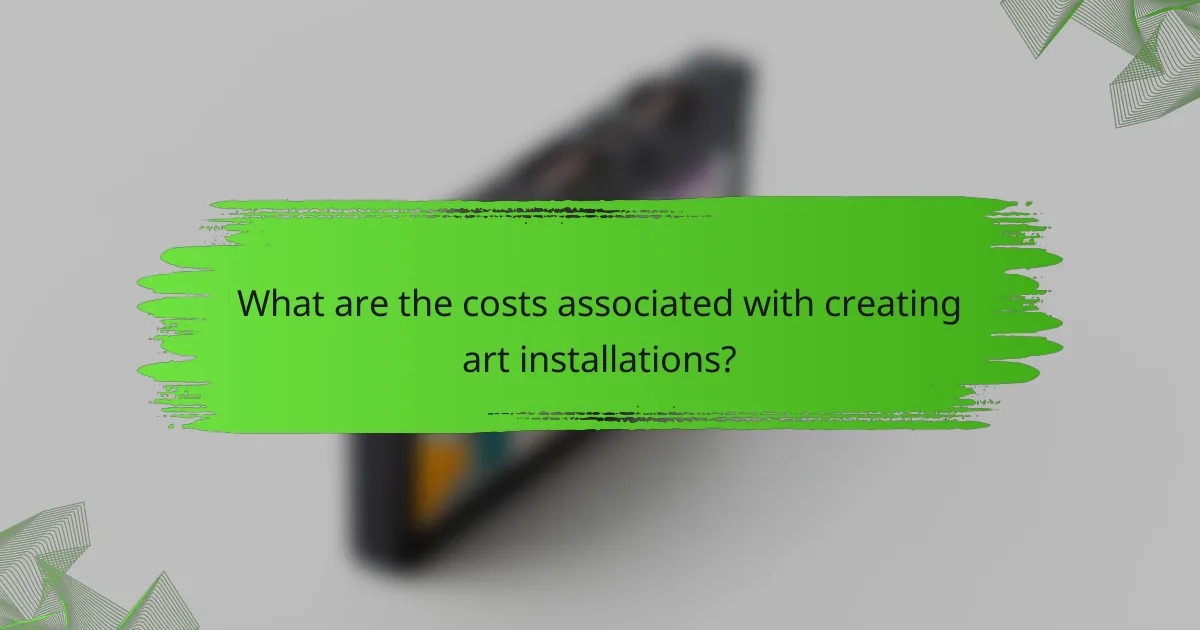
What are the costs associated with creating art installations?
Creating art installations involves various costs that can significantly impact the overall budget. Key expenses include material costs, labor, and installation expenses, which can vary widely based on the complexity and scale of the project.
Material costs
Material costs for art installations can range from a few hundred to several thousand dollars, depending on the type of materials used. Common materials include wood, metal, glass, and fabric, each with its own price range. For example, high-quality metals may cost more than basic plywood.
When planning, consider sourcing materials locally to reduce shipping fees and support local businesses. Additionally, using recycled or repurposed materials can lower costs while adding unique character to the installation.
Labor and installation expenses
Labor costs typically account for a significant portion of the budget for art installations. This includes hiring artists, craftsmen, and technicians, whose rates can vary based on experience and location. In urban areas, labor costs may be higher due to demand.
Installation expenses can also include equipment rental, transportation, and site preparation. It’s essential to budget for these costs upfront to avoid surprises. Engaging a project manager can help streamline the process and ensure that all aspects of labor and installation are accounted for effectively.
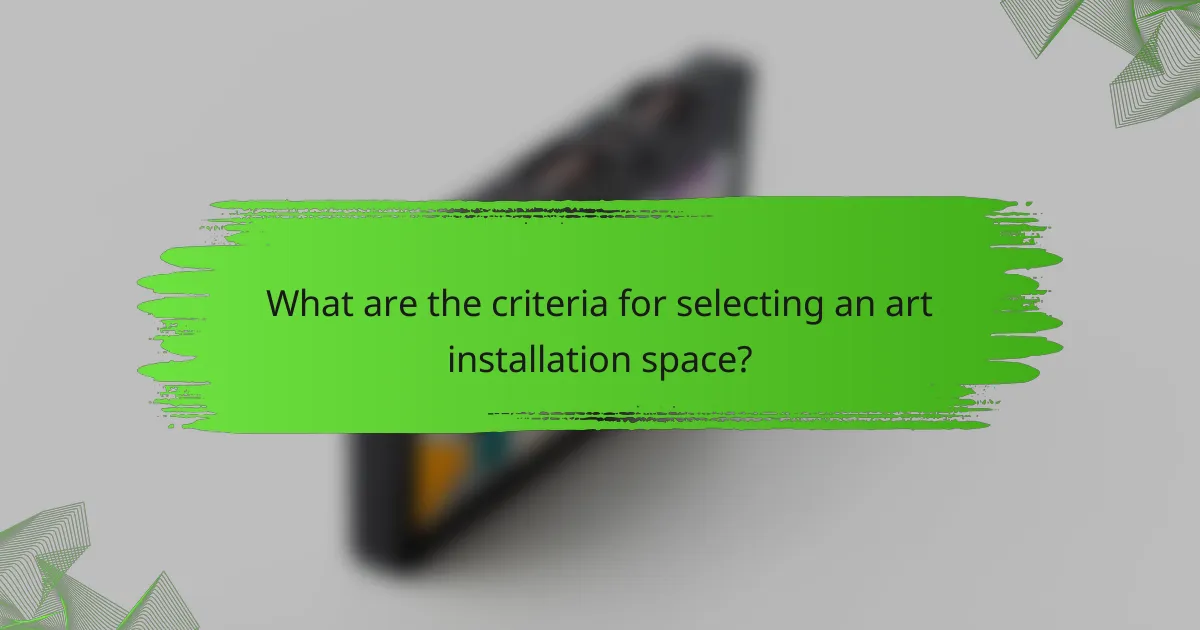
What are the criteria for selecting an art installation space?
Selecting an art installation space involves considering factors such as visibility, foot traffic, and the physical dimensions of the area. These criteria help ensure that the installation reaches its intended audience and functions effectively within the environment.
Foot traffic and visibility
Foot traffic and visibility are crucial for the success of an art installation. High foot traffic areas, such as busy streets or popular public spaces, increase the likelihood of engagement from passersby. Consider locations near shopping districts, cultural centers, or transit hubs where people naturally congregate.
Visibility also affects how well the installation can be appreciated. Ensure that the space allows for clear sightlines and that the artwork is not obstructed by other structures or installations. A well-placed installation can attract attention and encourage interaction.
Space dimensions and layout
The dimensions and layout of the space play a significant role in how an art installation is perceived and interacted with. Measure the area to ensure that the installation fits comfortably without overwhelming the space or being too cramped. Consider the height, width, and depth of the installation in relation to the surrounding environment.
Additionally, the layout should facilitate movement and engagement. Ensure that there is enough room for viewers to walk around and interact with the installation. Avoid layouts that create bottlenecks or restrict access, as these can deter engagement and diminish the overall experience.

How do art installations impact local economies?
Art installations significantly influence local economies by attracting visitors and enhancing community engagement. They create opportunities for economic growth through tourism and increased spending in local businesses.
Boosts tourism
Art installations serve as major attractions that draw tourists to a region, often resulting in increased foot traffic and visibility for local attractions. Cities that host large-scale art events or installations can see a surge in visitors, particularly during festivals or exhibitions.
For example, cities like Berlin and Melbourne have successfully leveraged art installations to enhance their cultural tourism appeal, leading to higher hotel occupancy rates and increased attendance at local events. This influx of tourists can lead to a ripple effect, benefiting various sectors such as hospitality, transportation, and entertainment.
Increases local business revenue
The presence of art installations can lead to a notable increase in revenue for local businesses. Restaurants, shops, and service providers often experience higher sales as visitors flock to the area to view the installations.
Local businesses can capitalize on this by offering themed products or services that align with the art installations. For instance, a café near an art installation might create special menu items inspired by the artwork, attracting both tourists and locals. Additionally, partnerships with artists for events or promotions can further enhance visibility and sales.

What are the emerging trends in interactive art installations?
Emerging trends in interactive art installations focus on enhancing user engagement through technology and sustainable practices. Artists are increasingly incorporating augmented reality and eco-friendly materials to create immersive experiences that resonate with audiences.
Use of augmented reality
Augmented reality (AR) is transforming interactive art installations by blending digital elements with the physical environment. Artists use AR to create layers of information and visuals that viewers can access through their smartphones or AR glasses, enhancing the overall experience.
For example, installations may feature QR codes that, when scanned, reveal animated components or additional narratives. This technology allows for a dynamic interaction, where the artwork evolves based on viewer participation, making each experience unique.
Sustainability in materials
Sustainability is becoming a crucial consideration in the creation of interactive art installations. Artists are increasingly opting for eco-friendly materials such as recycled plastics, biodegradable substances, and locally sourced resources to minimize environmental impact.
Using sustainable materials not only reduces waste but also conveys a message about environmental responsibility. Artists can engage audiences by highlighting the importance of sustainability, encouraging viewers to reflect on their own consumption habits and the ecological footprint of art.



